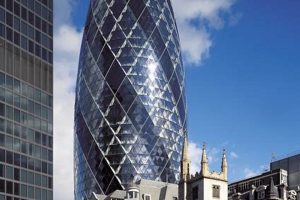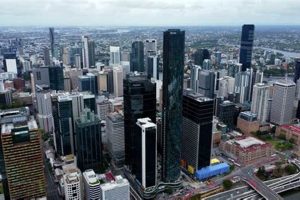Houston, located in the southern region of the United States, is renowned for its impressive skyline, dominated by a multitude of towering skyscrapers that have transformed the city’s architectural landscape.
The presence of these skyscrapers has significantly contributed to Houston’s economic growth and global recognition. The city’s skyline serves as a symbol of its thriving energy industry and vibrant business environment, attracting numerous corporations and professionals alike. Moreover, the architectural marvels of Houston’s skyscrapers have garnered international acclaim, showcasing the city’s commitment to innovation and design excellence.
The following section delves into the specific characteristics and iconic landmarks that define Houston’s skyscraper-studded skyline, exploring their architectural significance and the impact they have had on the city’s identity.
1. Height
The height of Houston’s skyscrapers is a defining characteristic that sets them apart from other skylines around the world. The JPMorgan Chase Tower, standing at 75 stories and 1,002 feet tall, is the tallest building in Texas and the 15th tallest in the United States. The Wells Fargo Plaza, with its 71 stories and 992 feet, is the second tallest building in Houston and the 20th tallest in the country.
- Economic Impact: The construction of these skyscrapers has had a significant economic impact on Houston, creating jobs and stimulating the local economy.
- Engineering Marvels: These towering structures are engineering marvels, showcasing the latest advancements in architecture and construction.
- Urban Planning: The height of Houston’s skyscrapers has influenced the city’s urban planning, with taller buildings being concentrated in the downtown area.
- Cultural Symbolism: The height of these skyscrapers has become a symbol of Houston’s growth, ambition, and prosperity.
The height of Houston’s skyscrapers is not simply a matter of aesthetics; it is a testament to the city’s economic vitality, engineering prowess, and cultural significance.
2. Architecture
Houston’s skyscrapers are not just about height; they are also about architectural diversity. The city’s skyline features a wide range of architectural styles, from the modern and sleek to the ornate and historical. This diversity reflects Houston’s rich history and its status as a global metropolis.
- Modern and Sleek: Many of Houston’s skyscrapers are characterized by their modern and sleek designs. These buildings often feature clean lines, geometric shapes, and reflective glass facades. Examples include the JPMorgan Chase Tower and the Wells Fargo Plaza.
- Ornate and Historical: Houston also has a number of ornate and historical skyscrapers. These buildings often feature intricate details, such as cornices, pilasters, and sculptures. Examples include the Niels Esperson Building and the Gulf Building.
- International Influences: Houston’s skyscrapers also reflect the city’s international influences. Some buildings, such as the Asia Society Texas Center, incorporate elements of Asian architecture. Others, such as the One Shell Plaza, draw inspiration from European architecture.
- Sustainability: In recent years, there has been a growing emphasis on sustainability in Houston’s skyscraper design. Many new skyscrapers are being built with energy-efficient features and eco-friendly materials.
The diversity of Houston’s skyscraper architecture is a testament to the city’s rich history, global influences, and commitment to innovation. From the modern and sleek to the ornate and historical, Houston’s skyscrapers are a reflection of the city’s unique character and its status as a major international metropolis.
3. Sustainability
Houston’s commitment to sustainability is evident in the design and construction of its skyscrapers. Many of these buildings incorporate energy-efficient features and eco-friendly materials, reducing their environmental impact and contributing to the city’s overall sustainability goals.
- Energy Efficiency: Houston’s skyscrapers employ various energy-efficient measures, such as high-performance glazing, efficient HVAC systems, and LED lighting, to minimize energy consumption and reduce operating costs.
- Water Conservation: Water-saving fixtures and rainwater harvesting systems are common features in Houston’s skyscrapers, helping to reduce water consumption and conserve this precious resource.
- Green Materials: Many Houston skyscrapers utilize eco-friendly materials, such as recycled steel, low-VOC paints, and sustainable wood products, to minimize their environmental impact.
- Sustainable Design: The design of Houston’s skyscrapers often incorporates passive design strategies, such as natural ventilation and daylighting, to reduce energy consumption and improve occupant comfort.
The emphasis on sustainability in Houston’s skyscrapers is driven by a combination of environmental consciousness, economic incentives, and regulatory requirements. By embracing sustainable practices, Houston’s skyscrapers contribute to the city’s long-term sustainability and enhance the well-being of its residents.
4. Views
The breathtaking views offered by Houston’s skyscrapers are an integral component of their allure and desirability. The upper floors of these towering structures provide panoramic vistas of the city and its surroundings, creating a unique and unforgettable experience for occupants, visitors, and tourists alike.
The elevated vantage point of Houston’s skyscrapers offers a bird’s-eye perspective of the city’s diverse neighborhoods, iconic landmarks, and sprawling urban landscape. These views not only enhance the aesthetic appeal of the buildings but also provide practical benefits, such as increased natural light and reduced noise pollution for occupants.
Moreover, the views from Houston’s skyscrapers serve as a constant reminder of the city’s growth and transformation. The ever-changing cityscape, with new buildings rising and old ones being renovated, is a testament to Houston’s dynamic and evolving nature.
5. Tenants
The presence of a diverse mix of businesses in Houston’s skyscrapers is not merely a coincidence; it is a reflection of the city’s economic vitality and its status as a major business hub in the United States. The skyscrapers provide a prestigious and convenient location for companies to establish their headquarters or regional offices, offering access to a skilled workforce, transportation infrastructure, and a global network of clients and partners.
The energy sector is a particularly significant tenant in Houston’s skyscrapers, given the city’s position as the “Energy Capital of the World.” Many of the world’s largest energy companies, including ExxonMobil, Chevron, and Shell, have their headquarters or major operations in Houston. The skyscrapers provide these companies with the space and infrastructure they need to conduct their global operations, from exploration and production to refining and distribution.
In addition to energy companies, Houston’s skyscrapers are also home to a significant number of financial institutions, including banks, investment firms, and insurance companies. The proximity to the Federal Reserve Bank of Dallas and other financial institutions makes Houston an attractive location for companies in the financial sector. The skyscrapers provide these companies with the necessary infrastructure and security measures to conduct their financial transactions and serve their clients.
Law firms are another major tenant group in Houston’s skyscrapers. The city is home to a large and sophisticated legal community, and the skyscrapers provide law firms with a prestigious and convenient location to serve their clients. The proximity to courthouses, government agencies, and other businesses makes Houston an ideal location for law firms to establish their offices.
The mix of businesses in Houston’s skyscrapers is a key component of the city’s economic success. The skyscrapers provide these businesses with the space, infrastructure, and prestige they need to operate and grow. In turn, these businesses contribute to the city’s tax base, create jobs, and support the local economy.
6. Economic impact
The construction and operation of Houston’s skyscrapers have a profound impact on the city’s economy. These towering structures are not just symbols of Houston’s prosperity; they are also major drivers of economic growth and job creation.
- Construction: The construction of a single skyscraper can create thousands of jobs for architects, engineers, construction workers, and other skilled laborers. These jobs provide a significant boost to the local economy, generating income and stimulating spending in various sectors.
- Operation: Once completed, skyscrapers require a large workforce to operate and maintain them. This includes building engineers, security guards, cleaning staff, and other personnel. These jobs provide stable employment opportunities for many people in the city.
- Rent and taxes: Skyscrapers generate substantial rental income for their owners, which contributes to the city’s tax base. This revenue can be used to fund essential public services, such as education, healthcare, and infrastructure, benefiting the entire community.
- Tourism: Houston’s skyscrapers are also a major tourist attraction, drawing visitors from around the world. Tourists spend money on hotels, restaurants, and other local businesses, further contributing to the city’s economy.
The economic impact of Houston’s skyscrapers is undeniable. These buildings are not just architectural marvels; they are also important engines of economic growth and job creation, contributing to the prosperity of the city and its residents.
7. Tourism
The connection between “Tourism: Houston’s skyscrapers are a popular tourist destination, attracting visitors from around the world.” and “houston skyscrapers” is undeniable. These towering structures are not just symbols of Houston’s economic vitality; they are also major attractions for tourists from around the globe.
There are several reasons why Houston’s skyscrapers are such popular tourist destinations. First, they offer breathtaking views of the city and surrounding landscape. Visitors can take in the sights from observation decks located at the top of many skyscrapers, such as the JPMorgan Chase Tower and the Wells Fargo Plaza. These views are especially stunning at night, when the city lights up like a glittering jewel.
Second, Houston’s skyscrapers are home to a variety of attractions, including restaurants, shops, and museums. Visitors can dine in upscale restaurants with panoramic views of the city, browse through unique shops offering a wide range of goods, and learn about Houston’s history and culture at museums such as the Museum of Fine Arts, Houston and the Houston Museum of Natural Science.
Finally, Houston’s skyscrapers are located in the heart of the city’s downtown area, which is home to a variety of other attractions, such as parks, theaters, and shopping malls. This makes it easy for visitors to combine their visit to the skyscrapers with other activities and experiences.
The tourism industry is an important part of Houston’s economy, and the city’s skyscrapers are a major draw for visitors. The revenue generated by tourism helps to support local businesses and create jobs. In addition, tourism helps to promote Houston’s image as a vibrant and cosmopolitan city.
The connection between “Tourism: Houston’s skyscrapers are a popular tourist destination, attracting visitors from around the world.” and “houston skyscrapers” is mutually beneficial. The skyscrapers provide a unique and memorable experience for visitors, while tourism helps to support the city’s economy and promote its image.
8. Urban planning
The placement and design of Houston’s skyscrapers have played a significant role in shaping the city’s urban planning and development. These towering structures have influenced everything from traffic patterns to population density, and they have helped to create a unique and recognizable skyline.
- Centralization of business and commerce: Houston’s skyscrapers are primarily concentrated in the downtown area, which has led to the centralization of business and commerce in the city. This has made it easier for businesses to interact with each other and has helped to create a sense of community among the city’s business leaders.
- Increased population density: The construction of skyscrapers has also led to an increase in population density in the downtown area. This is because skyscrapers can accommodate more people than traditional low-rise buildings, and they are often located near public transportation and other amenities that make them attractive to residents.
- Improved transportation infrastructure: The construction of skyscrapers has also led to improvements in transportation infrastructure in the downtown area. This is because skyscrapers generate a lot of traffic, and the city has had to invest in new roads, bridges, and public transportation lines to accommodate this traffic.
- Creation of a unique skyline: Houston’s skyscrapers have also helped to create a unique and recognizable skyline for the city. The city’s skyline is constantly evolving as new skyscrapers are built, but it is always dominated by a few iconic buildings, such as the JPMorgan Chase Tower and the Wells Fargo Plaza.
The placement and design of Houston’s skyscrapers have had a profound impact on the city’s urban planning and development. These towering structures have helped to create a vibrant and dynamic city that is known for its business, culture, and architecture.
9. Cultural significance
Houston’s skyscrapers are more than just tall buildings; they are symbols of the city’s growth, ambition, and prosperity. These towering structures have played a significant role in shaping Houston’s identity and have come to represent the city’s economic vitality and global aspirations.
The construction of skyscrapers in Houston began in the early 20th century, following the discovery of oil in the Gulf of Mexico. As the city’s economy boomed, so too did its skyline. In the 1970s and 1980s, Houston experienced a particularly significant construction boom, which resulted in the completion of several iconic skyscrapers, including the JPMorgan Chase Tower and the Wells Fargo Plaza. Today, Houston is home to more than 50 skyscrapers, making it one of the top ten cities in the United States in terms of skyscraper count.
The presence of skyscrapers in Houston has had a profound impact on the city’s culture and identity. These buildings have come to represent the city’s economic power and its ambitions to be a major player on the global stage. Skyscrapers have also helped to create a sense of community and pride among Houstonians, who see these buildings as symbols of their city’s success.
In addition to their symbolic value, Houston’s skyscrapers also have a practical significance. These buildings provide much-needed office space for the city’s businesses and help to attract new businesses to the area. Skyscrapers also generate significant tax revenue for the city, which can be used to fund essential public services.
Houston’s skyscrapers are a testament to the city’s growth, ambition, and prosperity. These buildings have played a significant role in shaping the city’s identity and have come to represent the city’s economic power and global aspirations.
Frequently Asked Questions about Houston Skyscrapers
Houston’s skyscrapers are a source of pride for the city and a symbol of its economic vitality. However, there are also some common questions and misconceptions about these towering structures.
Question 1: Are Houston’s skyscrapers safe?
Yes, Houston’s skyscrapers are safe. They are built to meet strict building codes and are regularly inspected to ensure their structural integrity. In addition, the city has a comprehensive emergency response plan in place to deal with any potential emergencies.
Question 2: Are Houston’s skyscrapers energy-efficient?
Yes, many of Houston’s skyscrapers are energy-efficient. They are built with features such as double-paned windows, energy-efficient lighting, and motion-sensor controls to reduce energy consumption. In addition, some skyscrapers are LEED-certified, which means they meet high standards for sustainability.
Question 3: Are Houston’s skyscrapers accessible to people with disabilities?
Yes, Houston’s skyscrapers are accessible to people with disabilities. They are equipped with ramps, elevators, and other features to ensure that people with disabilities can easily access and navigate the buildings.
Question 4: Can the public visit the observation decks of Houston’s skyscrapers?
Yes, the public can visit the observation decks of some of Houston’s skyscrapers. The JPMorgan Chase Tower and the Wells Fargo Plaza both have observation decks that offer stunning views of the city.
Question 5: Are Houston’s skyscrapers earthquake-proof?
Houston’s skyscrapers are designed to withstand earthquakes. The city is located in a relatively low-seismic zone, but the buildings are built with features such as reinforced concrete and steel frames to ensure their stability in the event of an earthquake.
Question 6: What is the tallest skyscraper in Houston?
The tallest skyscraper in Houston is the JPMorgan Chase Tower, which stands 1,002 feet tall. It is the tallest building in Texas and the 15th tallest building in the United States.
These are just a few of the most frequently asked questions about Houston’s skyscrapers. For more information, please visit the websites of the individual buildings or the Houston Downtown Management District.
Houston’s skyscrapers are an important part of the city’s skyline and a source of pride for its residents. They are safe, energy-efficient, and accessible to people with disabilities. The public can visit the observation decks of some of the skyscrapers to enjoy stunning views of the city.
As Houston continues to grow and develop, its skyline will likely continue to change. New skyscrapers will be built, and older ones will be renovated. However, the city’s commitment to safety, sustainability, and accessibility will remain.
Tips for Houston Skyscrapers
Houston skyscrapers are a marvel of modern architecture and engineering, offering breathtaking views and luxurious amenities. Here are five tips to make the most of your experience in Houston’s skyscrapers:
Tip 1: Visit the observation decks.
Many of Houston’s skyscrapers have observation decks that offer stunning views of the city and surrounding area. The JPMorgan Chase Tower and the Wells Fargo Plaza both have observation decks that are open to the public.
Tip 2: Dine in a rooftop restaurant.
Several Houston skyscrapers have rooftop restaurants that offer fine dining with panoramic views. These restaurants are a great place to enjoy a special occasion or simply take in the sights of the city while enjoying a delicious meal.
Tip 3: Attend an event in a skyscraper.
Many Houston skyscrapers host events throughout the year, such as concerts, art exhibits, and conferences. These events are a great way to experience the inside of a skyscraper and learn more about the building’s history and architecture.
Tip 4: Take a guided tour.
Some Houston skyscrapers offer guided tours that take visitors behind the scenes and provide insights into the building’s design, construction, and operation. These tours are a great way to learn more about the engineering and architectural marvels of Houston’s skyscrapers.
Tip 5: Visit the surrounding area.
Houston’s skyscrapers are located in the heart of the city’s downtown area, which is home to a variety of other attractions, such as parks, theaters, and shopping malls. Be sure to explore the surrounding area to get a complete experience of all that downtown Houston has to offer.
By following these tips, you can make the most of your experience in Houston’s skyscrapers and enjoy the stunning views, luxurious amenities, and unique events that these buildings have to offer.
Conclusion
Houston’s skyscrapers are a testament to the city’s economic vitality, architectural prowess, and global aspirations. These towering structures have shaped Houston’s skyline and played a significant role in the city’s growth and development.
The skyscrape
rs of Houston are more than just tall buildings; they are symbols of the city’s ambition and success. They are a source of pride for Houstonians and a reminder of the city’s bright future. As Houston continues to grow and develop, its skyline will likely continue to change. New skyscrapers will be built, and older ones will be renovated. However, the city’s commitment to safety, sustainability, and accessibility will remain.







